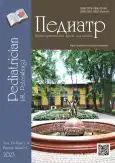Intestinal microflora in children with secondary hyperoxaluria and allergic respiratory diseases
- Authors: Obukhova A.N.1, Khaletskaya O.V.1, Shchelchkova N.A.1, Seliverstov A.N.1, Shirokova I.Y.1, Chekanina O.M.1, Ermolina E.V.1
-
Affiliations:
- Privolzhsky Research Medical University
- Issue: Vol 14, No 6 (2023)
- Pages: 15-23
- Section: Original studies
- URL: https://journals.rcsi.science/pediatr/article/view/256905
- DOI: https://doi.org/10.17816/PED626376
- ID: 256905
Cite item
Abstract
BACKGROUND: The intestinal microflora has an important role in the human body by influencing metabolic processes. It is proved that changes in intestinal microbiocenosis can cause the development of diseases. To date, the state of the intestinal microflora in children with impaired oxalate metabolism in combination with allergic pathology remains insufficiently studied.
AIM: The aim of the research was to study the intestinal microflora in children with secondary hyperoxaluria and allergic respiratory diseases.
MATERIALS AND METHODS: We examined 50 children aged 3 to 7 years with a diagnosis of secondary hyperoxaluria. The children were divided into two groups: group I — children with secondary hyperoxaluria and allergic respiratory diseases (n = 21); group II — children with secondary hyperoxaluria without allergic respiratory diseases (n = 29). All patients underwent a study of the state of intestinal microflora using fecal analysis by real-time PCR with fluorescence detection. The high-performance liquid chromatography method was used to determine the level of short-chain fatty acids in the feces of patients with secondary hyperoxaluria and allergic respiratory diseases.
RESULTS: The level of oxaluria is higher in patients with a combination of secondary hyperoxaluria and allergic respiratory diseases than with isolated secondary hyperoxaluria (p = 0.018). Changes in the intestinal microflora were detected in all patients with secondary hyperoxaluria (100%, n = 50). Сhildren with secondary hyperoxaluria and allergic respiratory diseases had a lower intestinal content of Faecalibacterium prausnitzii (p = 0.004) and Ruminococcus spp. (p = 0.017), there were also violations of the metabolic activity of bacteria, manifested by a decrease in the concentration of monocarboxylic acids: acetic (0.18 ± 0.09), butyric (0.006 ± 0.003), valerian (0.003 ± 0.001).
CONCLUSIONS: Secondary hyperoxaluria in children aged 3 to 7 years is combined with a violation of the intestinal microflora, more pronounced in allergic respiratory diseases.
Full Text
##article.viewOnOriginalSite##About the authors
Anna N. Obukhova
Privolzhsky Research Medical University
Author for correspondence.
Email: obukhovaanna@mail.ru
ORCID iD: 0000-0002-8070-5785
SPIN-code: 4682-5309
MD, PhD, Assistant Professor, Department of Hospital Pediatrics
Russian Federation, Nizhny NovgorodOlga V. Khaletskaya
Privolzhsky Research Medical University
Email: ovh14@mail.ru
ORCID iD: 0000-0002-8531-3174
SPIN-code: 9342-9261
MD, PhD, Dr. Sci. (Medicine), Professor, Head, Department of Hospital Pediatrics
Russian Federation, Nizhny NovgorodNatalia A. Shchelchkova
Privolzhsky Research Medical University
Email: n.shchelchkova@mail.ru
ORCID iD: 0000-0001-6398-4746
SPIN-code: 5248-7529
PhD, Associate Professor, Head, Central Research Laboratory of the Institute of Fundamental Medicine, Department of Normal Physiology named after N.Y. Belenkov
Russian Federation, Nizhny NovgorodAndrey N. Seliverstov
Privolzhsky Research Medical University
Email: andselisk@gmail.com
ORCID iD: 0000-0002-2602-6247
SPIN-code: 9585-1623
Researcher, Central Research Laboratory of the Institute of Fundamental Medicine
Russian Federation, Nizhny NovgorodIrina Yu. Shirokova
Privolzhsky Research Medical University
Email: shirokova.i@yandex.ru
ORCID iD: 0000-0002-8387-6344
SPIN-code: 9123-1213
MD, PhD, Associate Professor, Head, Bacteriological Laboratory of the Research Institute of Preventive Medicine of the University Clinic of the Federal State Educational Institution, Department of Epidemiology, Microbiology and Evidence-Based Medicine
Russian Federation, Nizhny NovgorodOksana M. Chekanina
Privolzhsky Research Medical University
Email: oksana-chekanina@mail.ru
ORCID iD: 0000-0002-6040-9866
SPIN-code: 9217-9430
Doctor of clinical and laboratory diagnostics, Research Institute of Preventive Medicine of the University Clinic
Russian Federation, Nizhny NovgorodElena V. Ermolina
Privolzhsky Research Medical University
Email: ermonay@gmail.com
ORCID iD: 0000-0002-6349-0890
SPIN-code: 4192-2480
Biologist, Research Institute of Preventive Medicine of the University Clinic
Russian Federation, Nizhny NovgorodReferences
- Abaseyeva TYU, Andrusev AM, Batyushin MM. Nephrology: Clinical Guidelines. Moscow: GEOTAR-Media; 2019. 851 p. (In Russ.)
- Ardatskaya MD. Clinical significance of short-chain fatty acids in gastrointestinal pathology [dissertation]. Moscow: 2003. 299 p. (In Russ.)
- Zainullina ON, Pechkurov DV, Lyamin AV, Zhestkov AV. Conditionally pathogenic Enterobacteriaceae in atopic dermatitis: is there a relationship? Questions of Pediatric Dietetics. 2018;16(5):32–38. (In Russ.) EDN: YWUVTF doi: 10.20953/1727-5784-2018-5-32-38
- Zolnikova OY, Ivashkin KV, Korneeva VR, Ivashkin VT. Microbiota of the gastrointestinal tract and allergic diseases: what is known? Issues in pediatric dietetics. 2020;18(1):48–55. (In Russ.) EDN: XPVHKZ doi: 10.20953/1727-5784-2020-1-48-55
- Zolnikova OYu, Potskhverashvili ND, Kokina NI, et al. Changes in intestinal microbiota as a risk factor for the development of bronchial asthma. Phys. 2020;31(1):3–7. (In Russ.) EDN: GYKLQT doi: 10.29296/25877305-2020-01-01
- Karpeeva YS, Novikova VP, Khavkin AI. Microbiota and human diseases. Dietary Issues. 2020;10(4):45–53. (In Russ.) EDN: DFOHRB doi: 10.20953/2224-5448-2020-4-45-53
- Potskhverashvili ND, Zolnikova OYu, Ivashkin VT. Role of intestinal microbiota in the pathogenesis of bronchial asthma. Molecular Medicine. 2022;20(3):11–19. (In Russ.) EDN: WBXSVK doi: 10.29296/24999490-2022-03-02
- Tlyustangelova RK, Dolinniy SV, Pshenichnaya NYu. The role of short-chain fatty acids in the pathogenesis of acute intestinal infections and post-infection syndromes. RMJ. 2019;27(10):31–35. (In Russ.) EDN: HECFJC
- Alvarez J, Fernandez Real JM, Guarner F, et al. Gut microbes and health. Gastroenterol Hepatol. 2021;44(7):519–535. doi: 10.1016/j.gastrohep.2021.01.009
- Assimos DG. Re: Oxalobacter formigenes: opening the door to probiotic therapy for the treatment of hyperoxaluria. J Urol. 2015;194(2):424–425. doi: 10.1016/j.juro.2015.05.039
- Bowerman KL, Rehman SF, Vaughan A, et al. Disease-associated gut microbiome and metabolome changes in patients with chronic obstructive pulmonary disease. Nature Communications. 2020;11(1):5886–5901. doi: 10.1038/s41467-020-19701-0
- Nazzal L, Francois F, Henderson N, et al. Effect of antibiotic treatment on Oxalobacter formigenes colonization of the gut microbiome and urinary oxalate excretion. Scientific Reports. 2021;11(1): 16428–16439. doi: 10.1038/s41598-021-95992-7
- Sadaf H, Raza S, Hassan S. Role of gut microbiota against calcium oxalate. Microb Pathog. 2017;109:287–291. doi: 10.1016/j.micpath.2017.06.009
- Zhao C, Yang H, Zhu X, et al. Oxalate-degrading enzyme recombined lactic acid bacteria strains reduce hyperoxaluria. Urology. 2018;113:253–253. doi: 10.1016/j.urology.2017.11.038
Supplementary files







